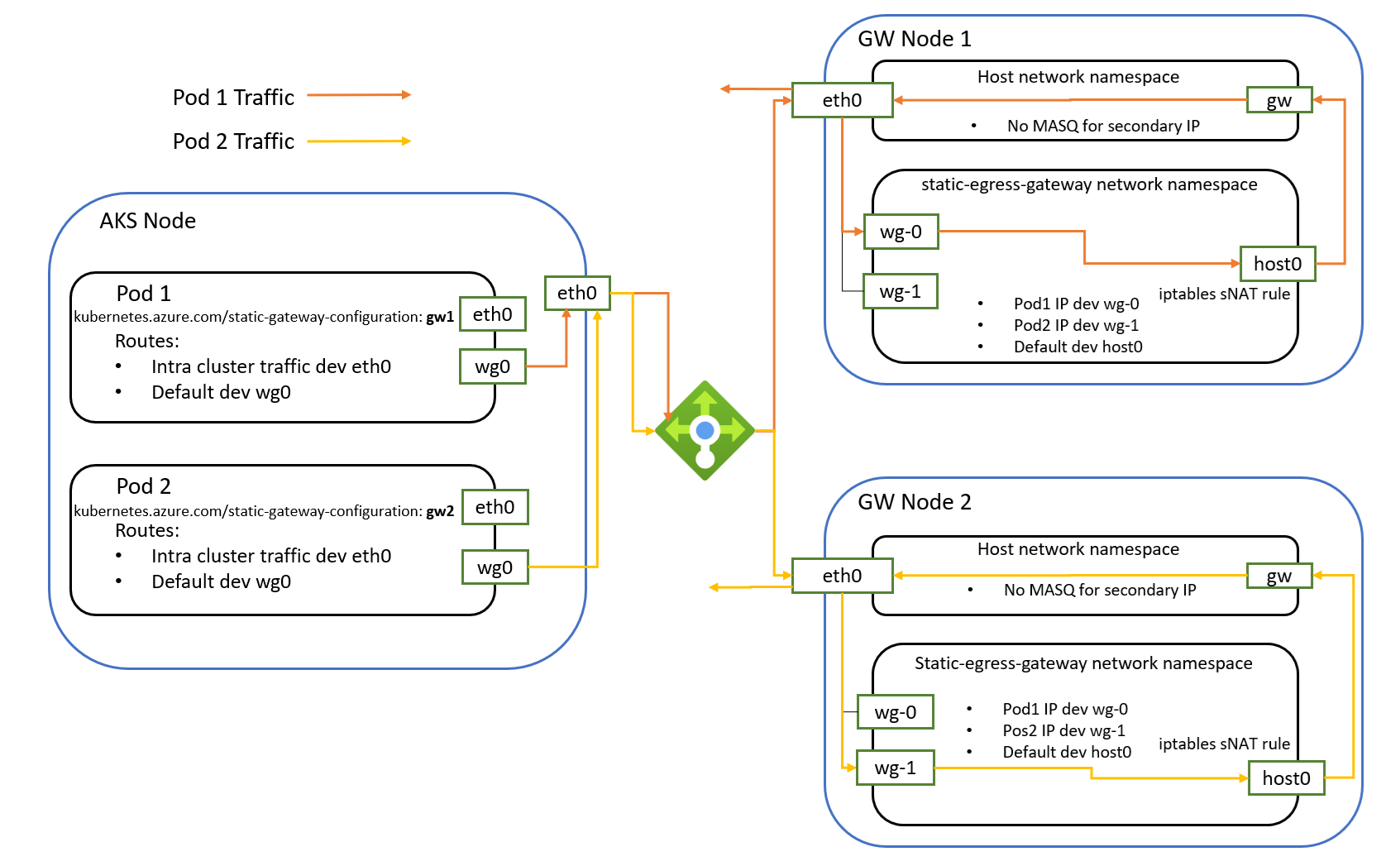kube-egress-gateway provides a scalable and cost-efficient way to configure fixed source IP for Kubernetes pod egress traffic on Azure. kube-egress-gateway components run in kubernetes clusters, either managed (Azure Kubernetes Service, AKS) or unmanaged, utilize one or more dedicated kubernetes nodes as pod egress gateways and route pod outbound traffic to gateway via wireguard tunnel.
Compared with existing methods, for example, creating dedicated kubernetes nodes with NAT gateway or instance level public ip address and only scheduling pods with such requirement on these nodes, kube-egress-gateway provides a more cost-efficient method as pods requiring different egress IPs can share the same gateway and can be scheduled on any regular worker node.
- Design doc provides details about how kube-egress-gateway works.
- Follow Installation guide to configure your Kubernetes cluster and install kube-egress-gateway components.
- Only Linux (Ubuntu or Azure Linux) based nodes are supported. Other Linux distributions have not been tested but may work. Windows node or pod support is not available at this time.
To deploy a static egress gateway, you need to create a StaticGatewayConfiguration CR:
apiVersion: egressgateway.kubernetes.azure.com/v1alpha1
kind: StaticGatewayConfiguration
metadata:
name: myStaticEgressGateway
namespace: myNamespace
spec:
gatewayVmssProfile:
vmssResourceGroup: myResourceGroup
vmssName: myGatewayVMSS
publicIpPrefixSize: 31
provisionPublicIps: true
publicIpPrefixId: /subscriptions/mySubscriptionID/resourcegroups/myResourceGroup/providers/Microsoft.Network/publicipprefixes/myPIPPrefix
defaultRoute: staticEgressGateway
excludeCidrs:
- 10.244.0.0/16
- 10.245.0.0/16StaticGatewayConfiguration is a namespaced resource, meaning a static egress gateway can only be used by pods in the same namespace. There are two required configurations:
gatewayVmssProfile: gateway vmss information:vmssName: Name of the Azure VirtualMachineScaleSet (VMSS) to be used as gateway nodepool.vmssResourceGroup: Azure resource group of gateway VMSS.publicIpPrefixSize: Length of the public IP prefix to be installed on the gateway nodepool as egress. In above example, 31 means a/31pip prefix, which contains 2 public IPs, will be installed. Note that gateway VMSS instance count cannot exceed this size. The gateway VMSS can only have 1 or 2 instances if public IP prefix size is 31. Likewise, at most 4 instances are allowed if public IP prefix size is 30. Otherwise, kube-egress-gateway operator will report error. At the time of writing, Azure only supports prefix sizes/28-/31.
provisionPublicIps: true if egress gateway needs Internet access. A public IP prefix will be associated with the gateway VMSS secondary IPConfiguration.
Three optional configurations:
publicIpPrefixId: BYO public IP prefix is supported. Users can provide Azure resource ID of their own public IP prefix in this field. Make sure kube-egress-gateway operator has access to the prefix. If not provided, a system generated prefix will be provisioned.provisionPublicIpsmust be true.defaultRoute: Enum, eitherstaticEgressGatewayorazureNetworking. Set it to bestaticEgressGatewayif traffic by default should be routed to the egress gateway orazureNetworkingif traffic should be routed to pods'eth0by default like regular pods. Default value isstaticEgressGateway.excludeCidrs: List of destination network CIDRs that should bypass the default route and flow via the other network interface. That is, ifdefaultRouteisstaticEgressGateway, cidrs set inexcludeCidrswill be routed via pod'seth0interface. For example, traffic within the cluster like pod-pod traffic and pod-service traffic should not be routed to the egress gateway and can be set here. On the other hand, ifdefaultRouteisazureNetworking, then only cidrs set inexcludeCidrswill be routed to the egress gateway.
kube-egress-gateway reconcilers manage the setup and resources and report the egress public IP prefix (private IPs) in StaticGatewayConfiguration status:
apiVersion: egressgateway.kubernetes.azure.com/v1alpha1
kind: StaticGatewayConfiguration
metadata:
name: myStaticEgressGateway
namespace: myNamespace
spec:
...
status:
egressIpPrefix: 1.2.3.4/31 # example public IP prefix output, this will be pods' egress IPNetIf provisionPublicIps is false, egressIpPrefix will be a list of private IPs configured on the corresponding gateway VMSS instance secondary ipConfigurations, e.g. 10.0.1.8,10.0.1.9.
Constructing a pod to use a static egress gateway is simple: just add pod annotation kubernetes.azure.com/static-gateway-configuration: <StaticGatewayConfiguration name>. Only name is required here because kube-egress-gateway CNI plugin always assume the gateway is in the same namespace as the pod. Note that existing pods must be recreated to enable egress gateway because CNI plugin can only take effect when pod is being created. See sample pod here.
Refer to troubleshooting guide and known issues.
This project welcomes contributions and suggestions. Most contributions require you to agree to a Contributor License Agreement (CLA) declaring that you have the right to, and actually do, grant us the rights to use your contribution. For details, visit https://cla.opensource.microsoft.com.
When you submit a pull request, a CLA bot will automatically determine whether you need to provide a CLA and decorate the PR appropriately (e.g., status check, comment). Simply follow the instructions provided by the bot. You will only need to do this once across all repos using our CLA.
This project has adopted the Microsoft Open Source Code of Conduct. For more information see the Code of Conduct FAQ or contact opencode@microsoft.com with any additional questions or comments.
This project may contain trademarks or logos for projects, products, or services. Authorized use of Microsoft trademarks or logos is subject to and must follow Microsoft's Trademark & Brand Guidelines. Use of Microsoft trademarks or logos in modified versions of this project must not cause confusion or imply Microsoft sponsorship. Any use of third-party trademarks or logos are subject to those third-party's policies.
